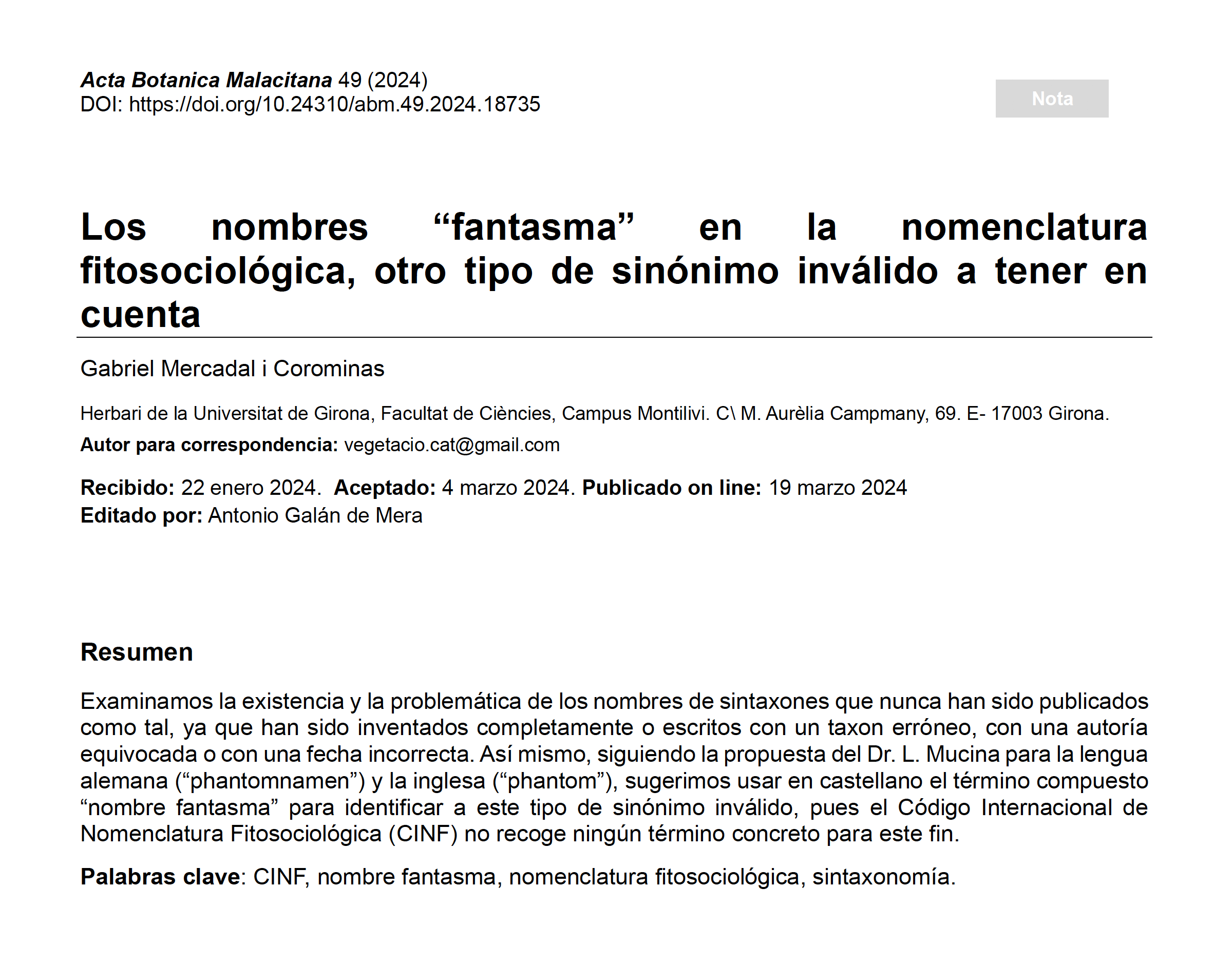“Phantom” names in phytosociological nomenclature, another type of invalid synonym to take into account
DOI:
https://doi.org/10.24310/abm.49.2024.18735Keywords:
ICPN, phantom name, phytosociological nomenclarue, syntaxonomyAbstract
We examine the existence and problems of syntaxa names that have never been published as such, because they have been completely invented or written with a wrong taxon, with a wrong authorship or with an incorrect date. Likewise, following Dr. L. Mucina's proposal for German ("phantomnamen") and English ("phantom"), we suggest using in Spanish the compound term "nombre fantasma" to identify this type of invalid synonym, as the International Code of Phytosociological Nomenclature (ICPN) does not include any specific term for this purpose.
Downloads
Metrics
References
Bolòs, O. de (1959). El paisatge vegetal de dues comarques naturals: la Selva i la Plana de Vic. Arxius de la secció de Ciències. Vol. XXVI. Barcelona: Institut d'Estudis Catalans.
Braun-Blanquet, J. (1931). Aperçu des Groupements végétaux du Bas-Languedoc. Communications de la Station Internationale de Géobotanique Méditerranéo-Alpine, 9, 35-40.
Braun-Blanquet, J. (1951). Pflanzensoziologie. Grundzüge der vegetationskunde (2ed.). Wien: Springer-Verlag.
Braun-Blanquet, J. (1964). Pflanzensoziologie. Grundzüge der vegetationskunde (3ed.). Wien: Springer-Verlag.
Braun-Blanquet, J., Roussine, N. & Nègre, R. (1952). Les Groupements Végétaux de la France Méditerranéenne. Paris: Centre National de Recherche Scientifique.
Curcó, A. (2001). La vegetación del delta del Ebro (V): las comunidades helofíticas e higrófilas (clases Phragmiti-Magnocaricetea y Molinio-Arrhenatheretea). Lazaroa, 22, 67-81.
Díaz, T. E. (1975). La vegetación del litoral occidental asturiano. Revista de la Facultad de Ciencias de la Universidad de Oviedo, 15-16(2), 369-545.
Ellmauer, T. & Mucina, L. (1993). Molinio-Arrhenatheretea. In L. Mucina, G. Grabherr & T. Ellmauer (Eds.), Die Pflanzengesellschaften Österreichs. Teil I – Anthoropogene Vegetation (pp. 297-401). Stuttgart: Gustav Fischer.
Esteso, F. (1992). Vegetación y flora del campo de Montiel. Interés farmacéutico. Albacete: Instituto de Estudios Albacetenses de la Excma. Diputación de Albacete.
Foucault, B. de (2001). Nouvelle contribution à une synsystématique des pelouses sèches à thérophytes. Documents Phytosociologiques, NS, 19, 47-105.
Gesti, J. (2006). El poblament vegetal dels aiguamolls de l'Empordà. Arxius de la seccions de ciències. Vol. CXXXVIII. Barcelona: Institut d'Estudis Catalans.
IAVS (2023). The Group for Phytosociological Nomenclature. International Association for Vegetation Science. Recurso electrónico en: https://www.iavs.org/page/working-groups_gpn. Consulta realizada el 12 de diciembre de 2023.
Mercadal, G. (2019). Els prats de dall de la terra baixa catalana. Caracterització geobotànica, valoració agroambiental i estudi de les relacions fitosociològiques entre els prats dalladors de l'Europa occidental. Volum 3: vegetació i gestió pradenca. Tesis doctoral. Girona: Universitat de Girona. https://doi.org/10.13140/RG.2.2.31802.21441
Mercadal, G. (2020). Caracterització geobotànica i validació fitosociològica de diversos sintàxons de prats de dall higròfils (ord. Deschampsietalia cespitosae) i mesohigròfils (ord. Trifolio-Hordeetalia) de Catalunya i de l’Europa occidental. Butlletí de la Institució Catalana d'Història Natural, 84: 163-193. https://doi.org/10.2436/20.1502.01.49
Mercadal, G. (2021). Geobotanical characterisation of the Trifolion squamosi nom. corr. alliance (class. Juncetea maritimi) in Catalonia and the Western Mediterranean. Hacquetia, 20(1), 107-117. https://doi.org/10.2478/hacq-2020-0019
Mercadal, G. (2022). Caracterización geobotánica de los herbazales higrófilos dominados por Phalaris arundinacea L. (all. Magnocaricion elatae) de la región costera de Cataluña (NE de la península ibérica). Acta Botanica Malacitana, 47, 15-25. https://doi.org/10.24310/abm.v47i.14259
Mercadal, G. (2023). Caracterización geobotánica de las asociaciones dominadas por Carex otrubaeo o Cyperus longus de la península ibérica y de Europa occidental. Acta Botanica Malacitana, 48, 105-136. https://doi.org/10.24310/abm.48.2023.17771
Mercadal, G., Vilar, L. & Gesti, J. (2006). Evolució de la vegetació de l'antic estany de Sils (la Selva) en els darrers 50 anys. Butlletí de la Institució Catalana de Història Natural, 74, 117-131.
Mercadal, G., Vilar, L. & Viñas, X. (2001). Els prats de dall de la plana de la Selva, l'últim hàbitat per a diverses plantes higròfiles a terra baixa. Butlletí de la Institució Catalana de Història Natural, 69, 19-24.
Mucina, L. (1993). Nomenklatorische und syntaxonomische Definitionen, Konzepte und Methoden. In L. Mucina, G. Grabherr & T. Ellmauer (Eds.), Die Pflanzengesellschaften Osterreichs. Teil I (pp. 19-28). Jena: Gustav Fischer.
Mucina, L., Bültmann, K., Dierßenm, K., Theurillat, J.-P., Raus, T., Čarni, A., Šumberová, K., Willner, W., Dengler, J., Gavilán, R., Chytrý, M., Hájek, M., Di Pietro, P., Iaukushenko, D., Pallas, J., Daniëls, F.J.A., Bergmeier, E., Santos Guerra, A., Ermakov, N., Valachovič, M.; Schaminée, J.H.J., Lysenko, T., Diduhk, Y.P., Pignatti, S., Rodwell, J.S., Capelo, J., Weber, H.E., Solomeshch, A., Dimopoulus, P., Aguiar, C., Hennekens, S.M. & Tichý, L. (2016). Vegetation of Europe: hierarchical floristic classification system of vascular plant, bryophyte, lichen, and algal communities. Applied Vegetation Science 19(1), 3-264. https://doi.org/10.1111/avsc.12257
Ninot, J.M., Carreras, J., Carrillo, E. & Vigo J. (2000). Syntaxonomic conspectus of the vegetation of Catalonia and Andorra. I: Hygrophilous herbaceous communities. Acta Botanica Barcinonensia, 46, 191-237.
Rivas Goday, S. & Fernández-Galiano, E. (1956). Resumen del itinerario botánico realizado por los miembros de la 10ª I.P.E. (En España 1953). Veröffentlichungen des Geobotanischen Institutes Rübel in Zürich, 31, 7-22.
Theurillat, J-P., Willner, W., Fernández-González, F., Bültamann, K., Carni, A., Gigante, D., Mucina, L. & Weber, H. E. (2021). International Code of Phytosociological Nomenclature. 4th edition. Applied Vegetation Science, 24, e12491, 1-62. https://doi.org/10.1111/avsc.12491
Tüxen, R. & Oberdorfer, E. (1958). Eurosibirische phanerogamen-Gesellschaften Spaniens. Die Pflanzenwelt Spaniens. Teil II. Veröffentlichungen des Geobotanischen Institutes Rübel in Zürich, 32, 1-328.
Zaliberová, M. & Škodová, I. (2014). Potentillion anserinae. In K. Hegedüšová & I. Škodová (Eds.), Rastlinné spoloèenstvá Slovenska. 5. Travinno-bylinná vegetácia. Veda: Bratislava.

Downloads
Published
How to Cite
Issue
Section
License
Copyright (c) 2024 Acta Botanica Malacitana

This work is licensed under a Creative Commons Attribution-NonCommercial-ShareAlike 4.0 International License.
All information related to the licensing of published works in Acta Botanica Malacitana and copyright can be found in our Editorial Policy.






1.png)
